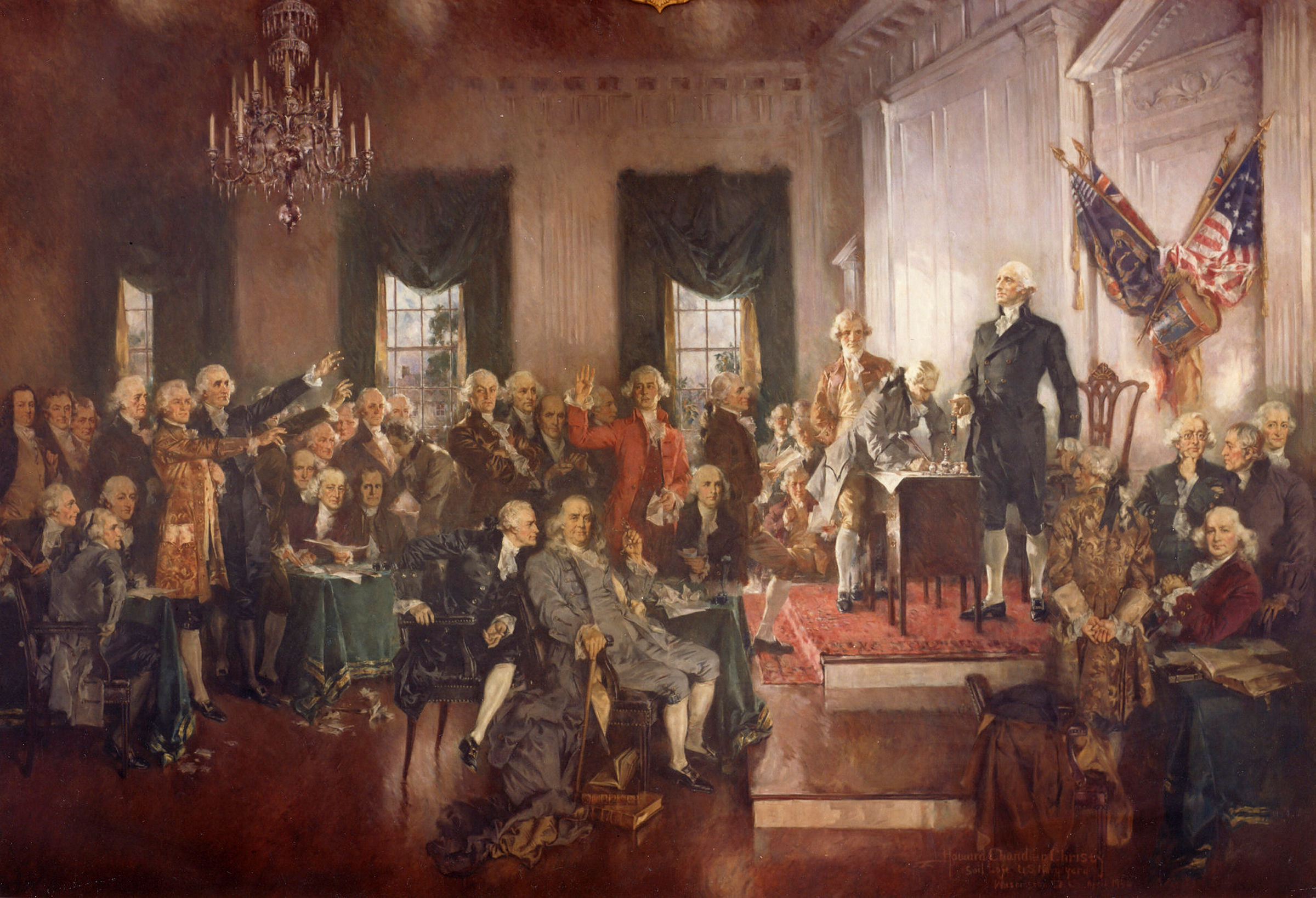WHAT THEY MEAN:
After the Fourth, Yorktown, the Treaty of Paris, and the Constitution, they began to argue …
Nobody really knows how large America’s early-republic economy was. The website www.measuringworth.com, an economic history project at the University of Illinois, nonetheless makes an admirable try, estimating a U.S. GDP of $189 million in 1790. We do know trade figures, though: that year, Alexander Hamilton’s newly hired Customs agents counted $23 million in imports and $20 million in exports.
Assuming the GDP estimate is about right, goods trade would have been equal to a bit less than 23% of the economy. Today’s trade and GDP stats, counted in trillions rather than millions of dollars, are about 100,000 times bigger. But measured against one another, they make the 21st-century and 18th-century economies look eerily similar. With the Bureau of Economic Analysis estimating U.S. GDP at $25 trillion this year and Census trade data suggesting $3.5 trillion in goods imports and $2.1 trillion in exports, the 2022 goods-trade-to-GDP ratio is just above 22%, almost identical to that of 1790.
Similar circumstances can elicit similar ideas and responses. In this post-Fourth week, here are some post-Independence perspectives, each with its own contemporary echoes and advocates:
1. Alexander Hamilton’s Report on Manufactures (1791) the first U.S. government paper on trade policy, was also the first on the topic now termed “competitiveness.” Then serving as Treasury Secretary, Hamilton rebuts arguments that low-wage foreign competition (from textile, machinery, and other factories in Industrial Revolution Britain and Europe) made it impossible for the U.S. to compete in manufacturing:
The balance of the Report calls for a program of importing labor-saving machines, passage of a patent law to stimulate American inventors, incentives for high-skilled immigration, cash prizes for innovative American factories, and an infant-industry trade protection scheme using temporarily high tariffs or exclusions for products ranging from starched wigs, bell-metal, and glue to whiskey, whale-oil, pewter cups and bowls, furniture, chocolate, rifles, and books. Hamilton’s former Federalist Papers partner, James Madison, was by then leader of an opposition party in the House of Representatives, and made sure the program got nowhere.
2. Thomas Jefferson’s Report on Foreign Commerce (1793), from a different angle two years later, is the first U.S. government catalogue of foreign trade barriers. Reviewing tariff rates, product exclusions, state trading monopolies, and shipping (“navigation”) restrictions in the U.K., France, Spain, Portugal, Denmark, Sweden, and the Netherlands along with their colonial possessions in Latin America, Canada, and the Caribbean, Jefferson as Secretary of State combines theoretical support for open markets with reciprocity in practice:
“Our bread stuff is at most times under prohibitory duties in England, and considerably dutied on re-exportation from Spain to her colonies. Our tobaccoes are heavily dutied in England, Sweden and France, and prohibited in Spain and Portugal. Our rice is heavily dutied in England and Sweden, and prohibited in Portugal. Our fish and salted provisions are prohibited in England, and under prohibitory duties in France. Our whale oils are prohibited in England and Portugal. And our vessels are denied naturalization in England, and of late in France. … Spain and Portugal refuse, to all those parts of America which they govern, all direct intercourse with any people but themselves. … We can carry no article, not of our own production, to the British ports in Europe, nor even our own produce to her American possessions.”
3. Thomas Paine and economic integration as a support for peace: And from a non-government, dissenting-intellectual perspective, Paine argues in The Rights of Man (1790) for international economic integration as a deterrent to war:

Policy then and now
Hamilton’s Report on Manufactures, 1791.
… and Commerce Secretary Gina Raimondo on U.S. supply chains, 2022.
Jefferson’s 7-country Report on Foreign Commerce.
… and the U.S. Trade Representative’s 2022 National Trade Estimate, covering 64 partners (counting the European Union and the Arab League as one each).
Paine’s The Rights of Man, 1790, with the commerce passage in chapter 5.
And some data
Census’ 1970 collection of trade data from the Colonial era and the early republic.
“Measuring Worth” tries to track GDP, wages, per capita income, and other stats for the U.S., Australia, the United Kingdom, and Spain back to the 1790s. Australia in 1790, two years after the Botany Bay colony foundation, has a GDP of 23,000 pounds.
And how exactly did we get modern economic macro-stats? BEA looks back on pre-GDP government economics, the giant brain of Simon Kuznets, and the invention of national economic measurement in the Commerce Department of the 1930s.
Ed Gresser is Vice President and Director for Trade and Global Markets at PPI.
Ed returns to PPI after working for the think tank from 2001-2011. He most recently served as the Assistant U.S. Trade Representative for Trade Policy and Economics at the Office of the United States Trade Representative (USTR). In this position, he led USTR’s economic research unit from 2015-2021, and chaired the 21-agency Trade Policy Staff Committee.
Ed began his career on Capitol Hill before serving USTR as Policy Advisor to USTR Charlene Barshefsky from 1998 to 2001. He then led PPI’s Trade and Global Markets Project from 2001 to 2011. After PPI, he co-founded and directed the independent think tank Progressive Economy until rejoining USTR in 2015. In 2013, the Washington International Trade Association presented him with its Lighthouse Award, awarded annually to an individual or group for significant contributions to trade policy.
Ed is the author of Freedom from Want: American Liberalism and the Global Economy (2007). He has published in a variety of journals and newspapers, and his research has been cited by leading academics and international organizations including the WTO, World Bank, and International Monetary Fund. He is a graduate of Stanford University and holds a Master’s Degree in International Affairs from Columbia Universities and a certificate from the Averell Harriman Institute for Advanced Study of the Soviet Union.
Read the full email and sign up for the Trade Fact of the Week